On July 4th, LAMP launched its First Coast Maritime Archaeology project in conjunction with Flinders University, in the form of a practicum or advanced maritime archaeological field school. The primary diving site for this two-week field school is a unique archaeological site–two shipwrecks at a single location.

Known as the “Steamship Wreck Site” because of the more prominent wreck, this archaeological site has been investigated by LAMP archaeologists before. Some 285 hours of bottom time were spent recording the steam machinery which stands proud of the seafloor. This consists of a large boiler rising around 8 feet or so from the bottom, a massive vertical engine standing around 10 feet from the bottom, and an intact propeller. But less than 12 feet away lies evidence of a second shipwreck, in the form of a small ballast pile with exposed timbers. These features are marked on this plan view of the site shown below:
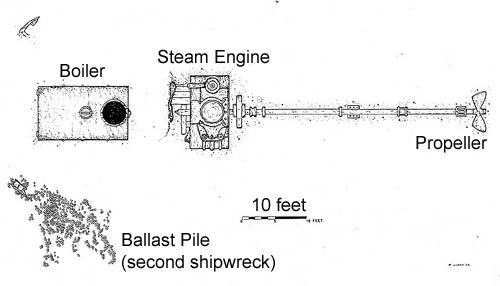
Despite the effort put into recording the steamship wreck, which included excavating to the wooden hull below the engine and building a scaled model of the machinery, LAMP has never excavated the ballast pile. As ballast would not be expected on a steamship, this feature most likely represents the bottommost remains of a wooden sailing ship. Without excavation, there is no way to accurately date this second shipwreck. We have several possible theories as to the origins of the two shipwrecks–they could have randomly wrecked at the same spot (which is located at the mouth of St. Augustine’s historical inlet), the sailing ship could have run into the wreckage of the steamer, or the steamer might have run into the wreckage of the sailing ship, which over time has lost its profile.
To answer these questions, and determine the relationship between the two wrecks, we will be excavating a trench across both vessel remains, just forward of the boiler. We will try to accomplish this goal during the field school, though work on this site can be challenging because of the poor water visibility which often plagues this area.
This is a really fascinating shipwreck site. When the visibility is good enough to see a few feet or more, it quickly becomes apparent that this wreck is an artificial reef that is home to lots of creatures. Schools of fish teem between the boiler and engine. The photo below shows the northeast corner of the boiler, with a colony of starfish.

The pile of ballast stones belonging to the unknown sailing ship is also home to a variety of marine life, including numerous sea urchins and stone crabs. Both of these residents can sometimes make working the site unpleasant for divers, especially when groping over the rocks in poor visibility.
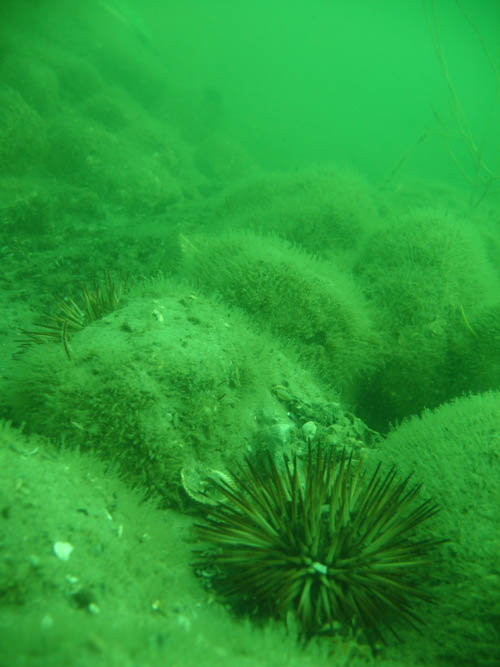

But the most exciting part for us is the archaeology of the site. As I write these we have spent four days diving the site, preparing it for excavation. We hope to use our hand-held dredges to trench through the sand and expose the hull remains of the vessels. In doing so we might find diagnostic or datable artifacts, such as broken pottery pieces, that might provide a date and nationality for this mystery ship.

One of our first tasks is to lay in a baseline. This is simply a line, marked at 1 meter intervals, strung tightly between two rebar stakes hammered into the sand. The baseline will serve as a frame of reference for mapping the entire site. The first step is to hammer in the rebar, as LAMP Director of Archaeology Sam Turner is doing below.

Next Deb Scheffi, a maritime archaeologist working for the State of Florida’s Bureau of Archaeological Research, affixes numbered tags to the baseline at meter intervals.
Once the baseline is in place, Flinders University professor Dr. Mark Staniforth uses it to measure the distance to various features in the ballast pile. These will later be added to an ongoing site plan of the site.
We take every opportunity to share our discoveries with the public. Last Sunday, July 8, a Canadian film crew shooting an hour-long show on St. Augustine came out to the site with us, and their cameraman Eli did a dive with us and filmed students and staff working underwater. After the underwater shoot they conducted a quick post-dive interview with me on the deck of the dive boat. The logistics behind such activity provide a good public archaeology lesson for the Flinders students.

The students also have opportunities to learn new technologies. One of the tools we are using is a hookah, which is a low-pressure compressor on deck that pumps air through hoses to the divers below. This allows us to spend more time underwater, carry less tanks on the boat, and provides the divers with a direct line back to the boat (which can be reassuring in low visibility). Here several students act as tenders for the divers, managing their hoses to give the diver slack and prevent tangle-ups.
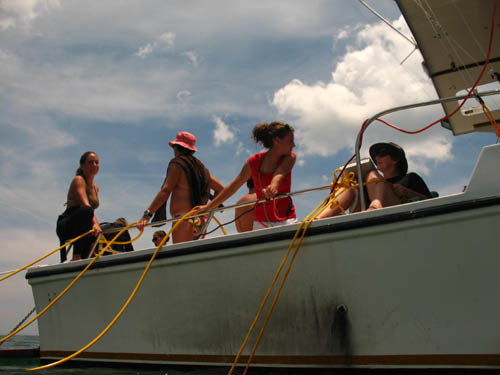
We purchased our electric and gasoline powered hookahs from Joe Sink at The Air Line, who supported our research by giving us a generous educational institution discount. So far they are performing great and we are very happy with their ease of use and reliability.
On a day of particularly good visibility, divers encounter a number of worm-eaten timbers that once made up the bottommost part of the sailing ship’s hull. Even these fragments can provide information about what kind of ship this was and details of its construction.
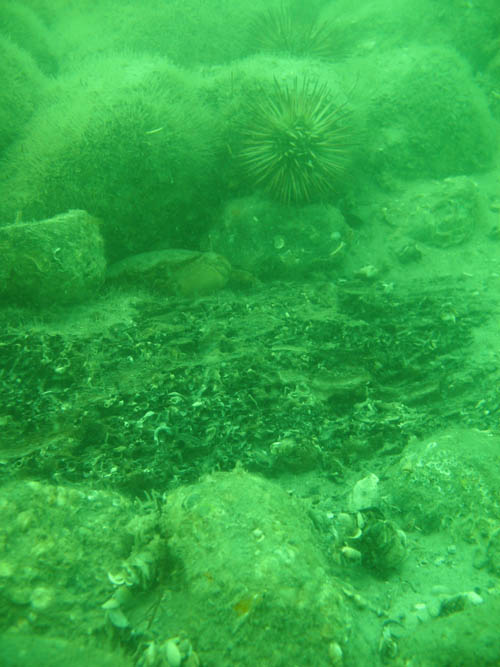
LAMP Director Chuck Meide (me) draws a quick sketch of the most significant area of exposed wood. We have observed frames (ribs) along with the ceiling planking that covered them, and also what appears to be a stringer running over one strake of ceiling planking.

The picture below, which shows these individual hull members, has been doctored in Photoshop to make these features more clear. That is why the green tint to the water has disappeared.

Underwater archaeology requires a lot of stuff. Here the crew is loading tanks, equipment, and other gear that has been moved from the boat to the dock at Vilano Beach.
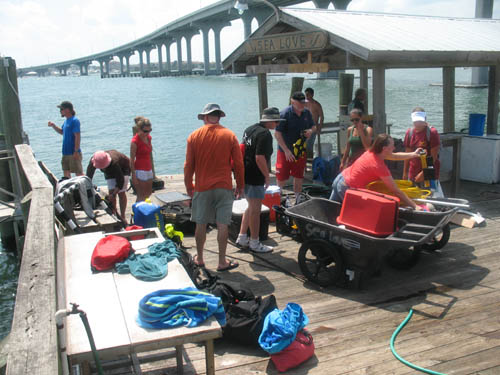
On this day, local captain Zach Timmons has generously allowed us to use his charter boat, Off the Grid III, for the cost of fuel only. The day before local charter captain Ron Keiser helped us out by providing us with his boat. We found both of these captains to be skilled and experienced and would recommend them to anyone wishing to charter a fishing boat in St. Augustine. You can reach Captain Ron at 914-672-0214. You can reach Captain Zach at 904-669-8853.
This support from both of these captains and their boats helped us accommodate the many visitors we have hosted since the start of the field school. In addition to the three-person film crew, we have hosted five University of West Florida students, one Florida State University student, one University of West Florida faculty member and Florida Public Archaeology Network regional director, two archaeologists from Southeastern Archaeological Research, Inc. in Gainesville, one faculty member from Clemson University and member of the Hunley Project, one professor from East Carolina University, the director of the Museum of Underwater Archaeology (who not only dived with us but served as a guest blogger), and three state archaeologists from the Florida Bureau of Archaeological Research. We are happy to host these visiting scientists who have traveled a long way to assist in the hands-on research into the maritime history of America’s oldest port, and the education of our students.

